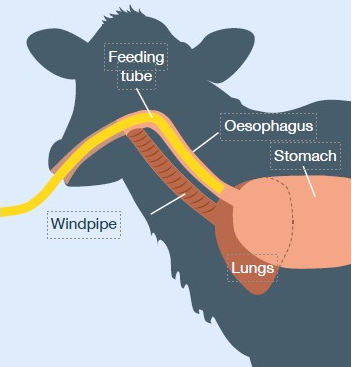Colostrum
Colostrum does not only provide nutrition to new born calves, it is a source of material antibodies that help to protect calves from bacteria in early life. It is crucial that calves receive adequate colostrum within the first two hours of life. Farmers should follow the 1,2,3 rule when feeding new-born calves. Using the 1,2,3 rule:- Use the first milk (colostrum) from the cow;
- Feed the calf colostrum within the first two hours of birth;
- Calves must be offered at least 3L of good-quality colostrum.
Handling of calf
The stomach tubing of calves can at times be difficult, but positioning the calf correctly to be tubed helps to make the process easier.A easy way of putting the calf in the correct position is as follows: while standing, place their back into a corner, with one hand under it's muzzle to keep the head and neck in a natural position.
Work calmly and quietly to minimise stress. You should be aware of the maternal instincts of the cow to protect her calf if you are completing the tubing in the calving shed. Ideally, you should remove the calf or cow from the calving pen before you attempt to stomach-tube the calf. Most farmers are aware of the dangers a freshly calved cow can pose, but complacency can set in, which may lead to an accident.Inserting tube
Before inserting the tube into a calves mouth you should moisten/ soften the end with either warm water or colostrum. Inspect the tube for damage and ensure that the tube is the correct length for the calf.If the tube is damaged in anyway it should not be used. A piece of plastic in a cow's stomach can cause serious damage to calves.
Slowly pass the tube over the tongue to the back of the mouth, ensuring the tube enters the oesophagus. You should be extremely careful to ensure the tube enters the oesophagus and not the windpipe. When the tube is in the correct location, the calf should be comfortable and swallowing.
Checking placement
Before allowing the milk to flow through the stomach tube, you should double check the placement of the tube. The easiest way to do this is to feel the calf's neck area. The windpipe is a hard structure, with rings obvious to touch. The oesophagus is a soft, collapsable structure.When the tube is correctly inserted you should be able to feel the tube - if you cannot feel the tube, remove the tube as it may be in the windpipe.
Reinsert the tube and check again that it is in the correct place. A incorrectly placed tube could be fatal to the calf.Hygiene
Stomach tubes should be thoroughly cleaned after each use. This should help to control the spread of bacteria from one calf to another. Milk residues should be removed before the tube is used on another calf. This will help to prevent the spread of Johne’s disease and other disease/bacteria.Johne's disease is caused by the bacterium Mycobacterium avium subspecies paratuberculosis (MAP) .
MAP is usually found in the milk of an infected cow so avoiding the mixing of colostrum is advised, especially in herds where Johne's disease is an issue. You should also have more than just one stomach tube on your farm. Ideally you should have a minimum of two - one to be used for colostrum and the second for feeding sick calves electrolytes. Using the same tube for colostrum and feeding sick calves is only aiding the spread of bacteria and disease in the calf shed.
